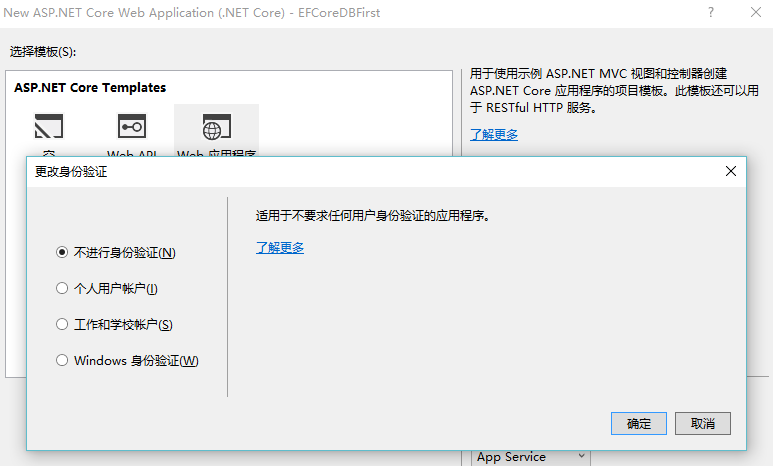ASP.NET Core (Database First)
CREATE DATABASE [EFCore_dbfirst] GO USE [EFCore_dbfirst] GO CREATE TABLE [Blog] ( [BlogId] int NOT NULL IDENTITY, [Url] nvarchar(max) NOT NULL, CONSTRAINT [PK_Blog] PRIMARY KEY ([BlogId]) ); GO CREATE TABLE [Post] ( [PostId] int NOT NULL IDENTITY, [BlogId] int NOT NULL, [Content] nvarchar(max), [Title] nvarchar(max), CONSTRAINT [PK_Post] PRIMARY KEY ([PostId]), CONSTRAINT [FK_Post_Blog_BlogId] FOREIGN KEY ([BlogId]) REFERENCES [Blog] ([BlogId]) ON DELETE CASCADE ); GO INSERT INTO [Blog] (Url) VALUES ('http://blogs.msdn.com/dotnet'), ('http://blogs.msdn.com/webdev'), ('http://blogs.msdn.com/visualstudio') GO
先创建数据库
创建一个新项目
这里我们选择 ASP.NET Core Web Application (.NET Core)

这里选择Web 应用程序,然后更改身份验证 改为 不进行身份验证

添加包
工具‣的NuGet包管理器‣包管理器控制台

- Run
Install-Package Microsoft.EntityFrameworkCore - Run
Install-Package Microsoft.EntityFrameworkCore.SqlServer
- Run
Install-Package Microsoft.EntityFrameworkCore.Tools –Pre - Run
Install-Package Microsoft.EntityFrameworkCore.SqlServer.Design
引用好以后我们在project.json -> tools 节点加上 "Microsoft.EntityFrameworkCore.Tools": "1.0.0-preview2-final"
"tools": {
"Microsoft.EntityFrameworkCore.Tools": "1.0.0-preview2-final",
"BundlerMinifier.Core": "2.0.238",
"Microsoft.AspNetCore.Razor.Tools": "1.0.0-preview2-final",
"Microsoft.AspNetCore.Server.IISIntegration.Tools": "1.0.0-preview2-final"
},
根据数据库生成EF
还是使用程序包管理控制台
执行
Scaffold-DbContext "Data Source=.;Initial Catalog=EFCore_dbfirst;User ID=sa;Password=sa.123" Microsoft.EntityFrameworkCore.SqlServer -OutputDir Models
分析一下这条命令
Scaffold-DbContext 命令名称 +"数据库连接字符串" + Microsoft.EntityFrameworkCore.SqlServer -OutputDir Models ( 这貌似是Provider参数)
注意
运行以下命令来创建从现有数据库的模型。如果您收到一个错误, ‘Scaffold-DbContext’ is not recognized as the name of a cmdlet ,请重新打开Visual Studio中。
执行成功后生成了如下代码

注册与依赖注入上下文(Register your context with dependency injection)
在ASP.NET Core,配置通常在 Startup.cs。为了符合这种模式,我们将移动数据库配置 到Startup.cs中。
EFCore_dbfirstContext 中
删除如下代码
protected override void OnConfiguring(DbContextOptionsBuilder optionsBuilder) { //#warning To protect potentially sensitive information in your connection string, you should move it out of source code. See http://go.microsoft.com/fwlink/?LinkId=723263 for guidance on storing connection strings. optionsBuilder.UseSqlServer(@"Data Source=.;Initial Catalog=EFCore_dbfirst;User ID=sa;Password=sa.123"); }
添加如下代码
public EFCore_dbfirstContext(DbContextOptions<EFCore_dbfirstContext> options) : base(options) { }
在 Startup.cs中 的 ConfigureServices方法 增加代码
这是增加后的效果
// This method gets called by the runtime. Use this method to add services to the container. public void ConfigureServices(IServiceCollection services) { services.AddDbContext<EFCore_dbfirstContext>(options => options.UseSqlServer("Data Source =.; Initial Catalog = EFCore_dbfirst; User ID = sa; Password = sa.123")); // Add framework services. services.AddMvc(); }
开始写代码
添加 BlogsController

using System; using System.Collections.Generic; using System.Linq; using System.Threading.Tasks; using Microsoft.AspNetCore.Mvc; using EFCoreDbFirst.Models; // For more information on enabling MVC for empty projects, visit http://go.microsoft.com/fwlink/?LinkID=397860 namespace EFCoreDbFirst.Controllers { public class BlogsController : Controller { private EFCore_dbfirstContext _context; public BlogsController(EFCore_dbfirstContext context) { _context = context; } public IActionResult Index() { return View(_context.Blog.ToList()); } public IActionResult Create() { return View(); } [HttpPost] [ValidateAntiForgeryToken] public IActionResult Create(Blog blog) { if (ModelState.IsValid) { _context.Blog.Add(blog); _context.SaveChanges(); return RedirectToAction("Index"); } return View(blog); } } }
添加 Index.cshtml

@model IEnumerable<EFCoreDbFirst.Models.Blog> @{ ViewBag.Title = "Blogs"; } <h2>Blogs</h2> <p> <a asp-controller="Blogs" asp-action="Create">Create New</a> </p> <table class="table"> <tr> <th>Id</th> <th>Url</th> </tr> @foreach (var item in Model) { <tr> <td> @Html.DisplayFor(modelItem => item.BlogId) </td> <td> @Html.DisplayFor(modelItem => item.Url) </td> </tr> } </table>
添加 Create.cshtml

@model EFCoreDbFirst.Models.Blog @{ ViewBag.Title = "New Blog"; } <h2>@ViewData["Title"]</h2> <form asp-controller="Blogs" asp-action="Create" method="post" class="form-horizontal" role="form"> <div class="form-horizontal"> <div asp-validation-summary="All" class="text-danger"></div> <div class="form-group"> <label asp-for="Url" class="col-md-2 control-label"></label> <div class="col-md-10"> <input asp-for="Url" class="form-control" /> <span asp-validation-for="Url" class="text-danger"></span> </div> </div> <div class="form-group"> <div class="col-md-offset-2 col-md-10"> <input type="submit" value="Create" class="btn btn-default" /> </div> </div> </div> </form>
来看看效果



